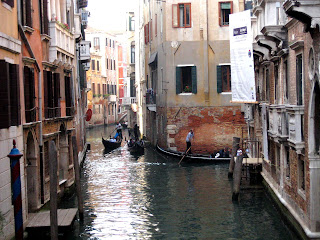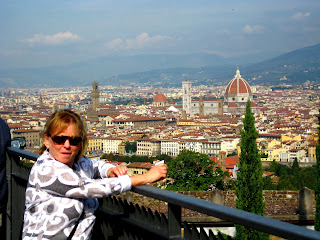Monday, October 15: Cannes
Maybe if you like basking in the sun, have your own villa and servants, and, of course, own a large ship with a helipad and a runabout, this might be a nice place to stop at for a few days. For us, a couple of hours sufficed.
Tuesday, October 16: Barcelona (again)
Since Bob's cold is still very much with us, and since, out of sympathy, I've come down with it too, we did not spend much time in Barcelona. We took the local bus to the Columbus statue at the base of the Ramblas. It was half the price of the ship's shuttle and faster. Then we wandered up the Ramblas and checked out the market that we'd never been to before. It's filled with stalls selling meat, fish, cheese, vegetables, candies, and sundry other things. Oh for such a place in Tucson! Then we wandered along the shorefront and caught the shuttle back in time for lunch with Gary.
In pm, watched Richard Gere in "Double" on our TV. Dinner with the whole group. I asked Aurelia if there was any conncedtion between her name and Marcus Aurelius. She said no. It's a corruption of some southern term of endearment. Went with her and Walt and G to Showtime at 9. Better than expected.
Thursday, October 18: Casablanca
Took the shuttle "in town." No indication where that was. Ended up being United Nations Plaza, which was all torn up. No idea where anything was. Went into Hyatt Hotel and got map and directions. Wandered for half an hour in the old city Medina. Not hassled by vendors. Wanted nothing, and saw nothing of interest. No one was interested in seeing the Hussain II Mosque, and I wasn't insistent, so we skipped that. Back to ship in about an hour. So that was all we saw of Africa.
Saturday, October 20: Maderia
Just a quick note from a cafe in Maderia, where there are way too many rich and delicious pastries. We stopped here instead of Ponta del Garda to avoid the hurricane. It worked, at least so far, since the sea is calm, the sun is out, and the island is both walkable from the ship and fun to explore.
This is our last stop, so this marks the end of the blog for this trip. We now have a week at sea crossing the Atlantic. Let's hope the hurricane has passed by already. -S
Many people have asked so I'll add that my cold is a lot better. By the time I get home I should be back to my old self. -B







































